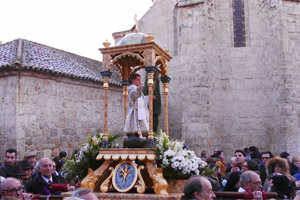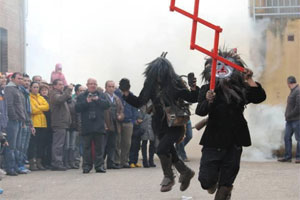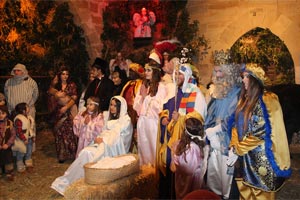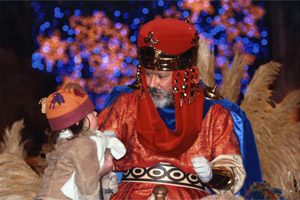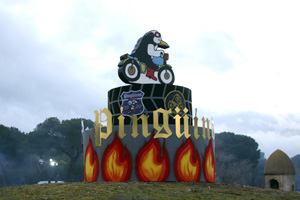San Froilán Festivities
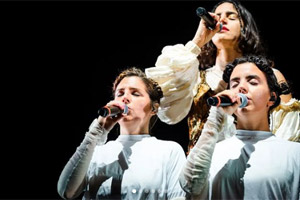
The Galician autumn dresses up with this great popular celebration that takes place in the province of Lugo, Galicia: the Festivities of San Froilán. Every year more than 500,000 visitors take part in this great celebration. The traditional background music, fireworks, open-air dances and concerts are the ideal setting to share and enjoy.
What are the San Froilán Festivities?
In October, the province of Lugo is the star of the San Froilán festivities. They are considered the most important patron saint festivities in Galicia, in homage to San Froilán, the patron saint of this town.
They have been declared a Festivity of National Tourist Interest, due to the large number of visitors who attend this popular festival every year.
How is this festival celebrated?
In October Lugo dresses up in festivities, music and colour. Various activities and events take place: parades of big-heads, street markets, brass bands, as well as magic shows, juggling and fireworks. The following days of festivities are particularly noteworthy:
On 5 October, religious ceremonies are held in honour of the patron saint San Froilán.
On Sunday the event known as "O Domingo das Mozas" is held, dedicated to exalting the traditional costume and Galician folklore.
The children can enjoy various fun-filled activities organised by San Froilanciño. They enjoy participating in popular games, plays and chess competitions. The most special moment is the International Puppet Festival, which exhibits the oldest puppets in Europe.
The festivities culminate on 12 October with the great Medieval Fair. Visitors and locals are transported back in time as they see a typical medieval market in the Cathedral square and around the Roman wall, with the participation of graceful minstrels and knights, falconry displays and traditional trades.
Not to be missed is the great medieval banquet with a typical Galician dish of the town: the famous "Pulpo a Feira". At nightfall the festivities culminate with a magnificent fireworks display.
Origins of the celebration of the San Froilán Festivities
The Festival of San Froilán originated as a religious celebration, in homage to the patron saint of the city of Lugo: San Froilán. It was celebrated for the first time in 1754.
With the passing of time, this festivity has become one of the most important popular festivities in Galicia. Every 5th October, hundreds of sellers, charlatans and healers would congregate, turning the city into a huge market: stalls selling fruit, vegetables, lace, clogs, pottery, farm implements, sweets, honey, bread, puppets.
The sale of livestock constituted a central axis in the celebration of these fairs of yesteryear, being the Livestock Fair of San Froilán one of the most important in Galicia.
Curiosities of the San Froilán Festivities
Get to know some curious and interesting facts about the San Froilán Festivities:
- The Pelúdez Family are funny characters that represent the idiosyncrasy of Lugo. They represent the traditional Galician family who come to taste a good octopus and enjoy the festive atmosphere of the city.
Recommendations for visitors
If you want to make the most of these festivities, here are some recommendations and practical tips:
- Wear comfortable clothes and footwear.
- During the days of this popular festival, Octopus Stalls are set up in different parts of Rosalía de Castro Park, where visitors can taste the traditional Pulpo á Feira (Octopus at the Fair).
What else can you do if you go to Lugo during the festival?
We recommend you visit these places of tourist and historical interest in Lugo:
- Roman Wall: a monument declared a World Heritage Site. It has an extension of two kilometres, allowing you to see the historic centre from above.
- The cathedral: religious building built during the Romanesque and Gothic periods. The chapel of the Virgen de los Ojos Grandes and the main altar stand out, with vaults decorated with large paintings.
- Provincial Museum: contains historical pieces including the refectory, the Romanesque cloister and the Baroque kitchen of the old Franciscan convent.
- San Roque Archaeological Centre: displays archaeological pieces and the remains of a Roman necropolis.
- Interactive Museum of the History of Lugo: it is an avant-garde building located in the Parque da Milagrosa, whose roof is made up of a large wooded garden of 11,300 square metres, with a set of circular courtyards.
Gastronomy
Discover some of the traditional dishes of the typical gastronomy of Lugo:
- Bonito de Burela: it is a typical local fish, which is prepared in different ways: grilled, boiled or in pies.
- Butelo de A Fonsagrada: this is a typical sausage made from pork ribs.
- Lacón trufado con huevo hilado: made with lean pork, chopped truffles, sherry and eggs.
- Queixo do Cebreiro: a fresh cheese made from cow's milk. Its consistency is a soft and grainy paste, which serves as the main ingredient for savoury dishes and desserts.
Share images, videos and interesting information about the San Froilán Festival on social networks. Use the hashtags #sanfroilan2022 #SanFroilán

